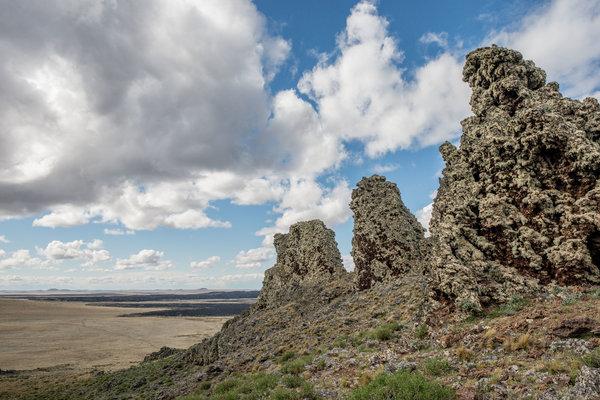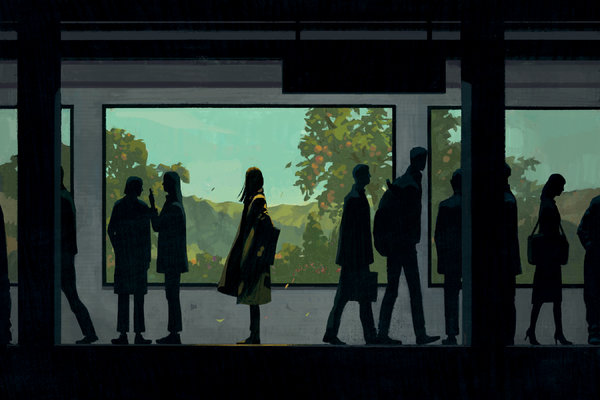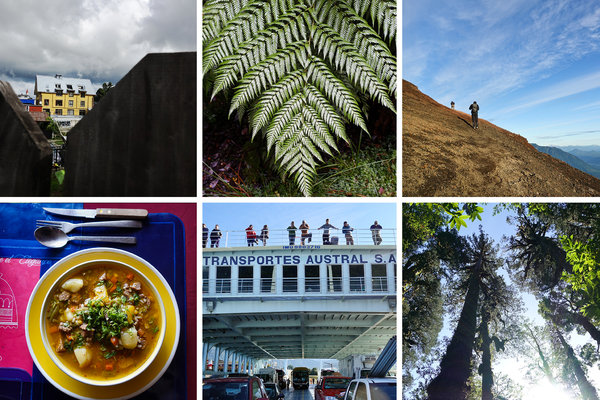The hiking trail leading to the Morada del Diablo volcano (the Devil’s Dwelling) crossed a field of blackened lava, congealed during the last ice age. Black lizards covered with white speckles, known as lagartijas Magallanicas, skittered across the ground, and the desiccated corpse of a guanaco, a wild grazer related to the llama, baked beneath the sun. A puma had probably killed it, my Chilean companion, Alvaro Soto, said.
I picked my way across the crust, pocked by holes just large enough to twist an ankle. After a mile, we climbed over a heap of rocks that slid beneath our feet and emerged at the summit of the crater.
Mr. Soto and I gazed across the maw at a scene of otherworldly bleakness: A curving wall, tinted green, splattered with bird feces, or whitewash, and riven with crevices, formed the volcano’s lip. Steep slopes of scree and soil laden with red-tinted hematite fell away into the abyss. The cries of buff-necked ibises, large rodent eaters with cream-and-russet throats and curving gray bills, echoed off the canyon. A peregrine falcon rose, plummeted into the crater, circled back up and disappeared inside a crevice.
We were deep inside Pali Aike National Park, one of the least visited, yet most dramatic reserves in Chile, 110 miles north of Punta Arenas. The Tehuelche hunter-gatherers who once dwelled here called this moonscape both “the place of desolation” and “the devil’s country,” and believed that evil spirits possessed it. It’s not hard to see why. The area is studded with volcanoes, formed during the Jurassic era 100 million years ago, by the collision of the Chile Rise and the Peru-Chile oceanic trench.
Three eruptions — the first taking place 3.8 million years ago, the most recent 15,000 years ago — covered the steppe with spills of black lava and pillars, columns and parapets of basalt, which glow yellow, red and greenish-gray in the harsh desert sunlight. Half a dozen craters and collapsed cones loom over the terrain like broken teeth.

View from inside a volcano at Pali Aike National Park, Chile.CreditTomas Munita for The New York Times
An Obscure Stop on the Route of Parks
Despite the bleakness, this 31-square-mile reserve, established by the Chilean government in 1970, teems with wildlife: hares, tuco-tucos (mole-like rodents), skunks, armadillos, gray foxes, pumas, guanacos, lizards and dozens of species of birds unique to Patagonia. Chilean flamingos, splashes of pink and orange in a charred landscape, gather in the park’s soda lakes. Buff-necked ibises build nests high in trees or inside the extinct volcanoes, sharing the ledges with peregrines — a symbiotic relationship rare among birds of prey.
Pali Aike is among the most obscure attractions on Chile’s new Route of Parks, a 1,740-mile wilderness trail that was unveiled earlier this year. The route was the culmination of a yearlong process that began in April 2017, when Kristine McDivitt Tompkins, the widow of the North Face founder, Douglas Tompkins, donated to the Chilean government one million acres of Patagonian wilderness through Tompkins Conservation, the nonprofit umbrella group of conservation initiatives that she co-founded and now leads. Out of that land, Chile carved two new reserves, Pumalín National Park Douglas Tompkins and Patagonia National Park Chile.
As part of the deal, the government set aside an additional nine million acres to enhance the country’s national park network. A total of 17 national parks have now been linked by the Route of Parks, a hiking trail that winds past mountains, glaciers, volcanoes, forests and arid steppe, and roughly follows the Carretera Austral, the country’s storied Southern Highway (also known as Route 7) through Patagonia.
Travelers who want an unmitigated dose of Chile’s wilderness can now travel from Alerce Andino National Park, near the city of Puerto Montt, to Cabo de Hornos National Park at the southern tip of the country. The new route reflects the Chilean government’s growing commitment to preserving Patagonia’s pristine landscapes — and its unparalleled bird life.
An Obsession with Birds
The birds were mainly what I had come to see. While doing research on an ornithological-related book over the past 18 months, I’ve traveled around the world, exploring bird-rich countryside in Scotland, the Rhondda Valley of southern Wales, and Matobo National Park in Matabeleland, Zimbabwe. None of those regions, however, compares with Patagonia, home not only to the pallid peregrine — a rare, white-breasted morph of the southern peregrine — but also to passerines, waders and carrion-eaters found only at the bottom of South America.
I made my forays from Punta Arenas, a windswept city of about 125,000 on the Strait of Magellan. Navigated by the Portuguese explorer Ferdinand Magellan in 1520, the strait remained one of only three options, along with the Drake Passage and Beagle Channel, to sail between the Atlantic and Pacific until the Panama Canal opened in 1914.
I stayed at the Hotel Plaza, a gaudy French neoclassical villa built by a family of cattle barons in the early 1920s, adjacent to the Plaza de Armas, otherwise known as the Plaza Muñoz Gamero, a leafy square in the city center. There I met Mr. Soto, a young photographer, bird-watcher and son of the local representative of the Servicio Agrícola y Ganadera (Department of Agriculture and Livestock), the government agency responsible for protecting Chile’s wildlife. He had agreed to be my guide for the trip. We rented a pickup truck and set out on a chilly spring morning at the height of nesting season through the Patagonian Steppe on the two-lane highway known as La Ruta del Fin del Mundo (The Highway at the End of the World).



Lesser rheas, known locally as ñandús, gray flightless birds that resemble ostriches, scurried away from our pickup truck amid clouds of dust. (Charles Darwin heard about them during the Beagle expedition of 1831-1836, and after searching fruitlessly for months, realized that he had been served one for a post-New Year’s Day meal; he preserved the head, legs and a wing for study and classification back in England.)
Guanacos, with brown coats and creamy white bellies, placidly munched the hardy yellow grass known as coirón. A few panic-stricken beasts leapt over the fences of cattle ranches along the road. “Some of them get snagged and can’t extricate themselves,” Mr. Soto said. They become easy prey for the pumas that prowl the pampas at dawn and dusk.
The Less-Traveled Route
A fork in the road presented two options. One branch bore left toward Puerto Natales, the gateway to Torres del Paine, a 700-square-mile expanse of glaciers, lakes and mountains, and one of the most popular parks in Patagonia. The less-traveled route, which we took, bore to the right in the direction of Pali Aike, and farther north, the Argentine town of Río Gallégos. The asphalt soon ran out, and a gravel track dipped and rose through bush-covered hills for about 15 miles. Then we arrived at a one-room ranger hut and a sign for the national park. I paid the gatekeeper 3,000 Chilean pesos (about $4.50), while Mr. Soto, as a Chilean citizen, paid nothing.
“You’re the first visitors in the park today,” the gatekeeper told us. It was 1 p.m. According to Chile’s National Forest Corporation, which administers the park, Pali Aike received just 2,537 visitors in 2016, half of whom were foreigners. That works out to seven people a day.
“This isn’t a park for everybody,” the gatekeeper said, adding that many visitors have a particular interest in volcanic geology or the fauna of Patagonia. He said he had started working at Pali Aike only two weeks earlier, after spending most of his life as a gaucho in southern Patagonia. Now in his 60s, he had decided he wanted a more sedentary existence. He invited us inside the hut to share a mate — the caffeine-rich drink consumed everywhere on the pampas — and served it the traditional way, repeatedly pouring boiling water into a mug stuffed with leaves, and inviting us to sip through a metal straw.
Gracias, I said, after the first sip. Then, when I asked for more, he gave me a lesson in mate-drinking etiquette. “We only say ‘gracias’ when we’re finished,” he said.
We spent an hour inside the caldera of the Morada del Diablo, perched behind a guardrail at the edge of the drop-off. Huge, encrusted pillars of basaltic lava loomed behind us, and the green, fissure-ridden lip of the collapsed volcano rose before us across the abyss. Savoring the silences, we watched three breeding pairs of buff-necked ibises cavorting in the cloudless sky. An inspection through binoculars of the lone peregrine falcon revealed the grayish underparts of the common cassini, and not the rarer pallid morph. Then we returned to the dirt lot where we had left our car, drove down the road, and hiked up a second extinct volcano, reaching the summit by a winding ascent up a dirt path.
In the late afternoon, the sun cast the elongated shadows of Pali Aike’s pyramidal hills and asymmetrical volcanic mounds on the desiccated grass. The rising trail skirted a cave once used by the Tehuelche, otherwise known as the Aónikenk, hunters who migrated here after the glaciers receded 10,000 years ago. Drawn to Pali Aike because of its abundant game, they were also fearful of it, seeing in the blackened ground and dead volcanoes the ubiquitous presence of el diablo.
On the yellow plain now far below us, a long line of guanacos — the Tehuelche’s sole source of protein, clothing and shelter — headed toward a pocket of water. Mr. Soto, armed with a guidebook to the birds of Chile, silently pointed to a small passerine with a brilliant red breast that had settled atop a lichen-covered lava tower beside us: It was a long-tailed meadowlark, a rare species found only in southern Patagonia and the Falkland Islands. A least seedsnipe, a small gray-and-brown bird, one of Patagonia’s most common, swooped down beside it.
As a late-afternoon chill set in, we drove across the plain to Laguna Ana, a salt lagoon near the park entrance. I walked along the soggy shore, drawn by a blur of orange at the other end of the lake. Sinking to my shins in the ooze, I extracted my legs with an unpleasant sucking sound, briefly panicking at the thought that I had stumbled into a pool of quicksand. Veering onto firmer ground, I peered through binoculars at what now revealed itself to be a flock of Chilean flamingos — slightly pinker than their North American cousins, with grayish legs, red joints and a mostly black bill — at the water’s edge. Driving outside of the park near sunset, Mr. Soto pointed out Southern caracaras, also called carrion hawks — imposing, vaguely menacing birds of prey with black crests, scarlet faces and sleek, black-and-gray feathers — perched on a dozen fence posts along the road.
We spent the night in Punta Delgada, a ramshackle settlement in a saddle between bare hills, near the narrowest crossing between the Chilean mainland, El Continente, and Tierra del Fuego. At the family-owned Hostal San Gregorio, we ate a hearty meal of noodles and roasted chicken, and received directions from the aged owners to the best spot in the area for seeing the rare peregrina pallida. I thanked the hostess for her hospitality the next morning, blurting out that I was not expecting to find such comfortable accommodations at the end of the world. She shrugged. “For us it’s not the end of the world, but for you we understand.”
An Avian Spectacle
Mr. Soto and I drove down a dirt road toward Bahía Posesíon, Possession Bay, an inlet of the Strait of Magellan, sandwiched between the mainland and Isla Grande, the largest of Tierra del Fuego’s islands. Sixty-foot sandstone cliffs, perfect falcon-nesting territory, run for miles along a deserted beach here. “This is not a tourist area,” Mr. Soto said.
Descending to the shore via a steep trail cut into the cliff, we approached a plywood shanty sheltered behind boulders. “I saw a pair of pallidos flying above the cliffs this morning,” the occupant, a fisherman in a black gaucho hat, told us. “Just head down the beach and you’ll find them.”
We hiked along a shoreline carpeted with mussel shells while scanning the cliffs — some bare, some blanketed in scrub and dwarf pine — for the aerie. Waves lapped over the shoal just off shore. Magellanic oystercatchers, black-and-white birds with elongated orange beaks, the better for plucking the meat from the bivalves’ shells, peeped hysterically over our heads. Southern giant petrels, big black seabirds also called Antarctic giant petrels, giant fulmars, stinkers, and stinkpots, flew in formation. Mr. Soto pointed out southern lapwings, cinnamon-bellied ground tyrants, and Austral negritos. The pallidos, alas, remained well concealed.
As we headed back toward Punta Arenas, one more avian spectacle awaited us. On a stretch of dirt road through the pampas, running parallel to the Bahía Posesíon, Mr. Soto motioned for me to pull over. Here, not marked on any map, lay a nondescript puddle, just a few dozen yards across, that seemed to have attracted every species of water bird in Patagonia. Thumbing through his guidebook, Soto identified red-gartered coots, white-tufted grebes, four varieties of ducks, blue-winged teals, silver teals, oystercatchers, upland and crested geese, tawny-throated dotterels, Magellanic snipe and, on hard ground yards past the pond, another cluster of flamingos.
We lingered for an hour, alone on the pampa, fascinated by the variety of avian life squeezed into such a small space. Our disappointment over missing the elusive pallid peregrine had receded. Mr. Soto tossed his bird book in the back seat, and we continued down the dirt track toward the Ruta del Fin del Mundo.
Joshua Hammer’s new book, “The Falcon Thief,” will be published by Simon & Schuster next year.
Follow NY Times Travel on Twitter, Instagram and Facebook. Get weekly updates from our Travel Dispatch newsletter, with tips on traveling smarter, destination coverage and photos from all over the world.







